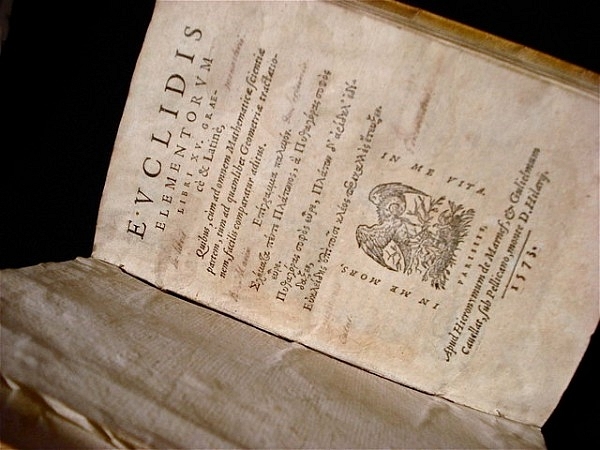Books
‘A Certain Ambiguity’: Fascinating Ride To The Limits Of Certainty
- A Certain Ambiguity: A Mathematical Novel (2007), authored by Gaurav Suri and Hartosh Singh Bal, explores the nature of certainty in mathematics and philosophy.

Euclid’s <i>Elements</i>, 1573 edition (Hector Zenil/Wikimedia Commons)
Every thinking human being tries to build their worldview from the store of their experiences, or by drawing upon one's reasoning powers or perhaps drinking from the fount of existing knowledge. Every human being also has a personal philosophy of life and existence, even if it were not as sophisticated as that of, say, Bertrand Russell.
Shakespeare memorably wrote, “There are more things in heaven and Earth,..., than are dreamt of in your philosophy.” There may come a time in one's life when this worldview gets shattered and one desperately clings to some beliefs – any beliefs. As they say, nature abhors a vacuum. Some may become devoutly religious, some others atheists or agnostics, and still others may find solace in, say, Spinoza's philosophy or Nietzsche's philosophy.
I believe that even practising science and mathematics requires a certain faith. In mathematics, we use the imaginary number to great success without any assurance that such a thing exists. In science, physicists use the Schrödinger and Dirac equations for the electron, which cannot be rigorously derived. Their success lies in their acceptance.
Gaurav Suri and Hartosh Singh Bal's dazzling A Certain Ambiguity: A Mathematical Novel (2007) is a work of fiction about the journey of an Indian mathematician in 1919 to a small town in the United States (US) upon receiving an invitation from a fellow mathematician. His journey, as seen through the eyes of his grandson, proves to be a transformational one.
This Indian mathematician, Vijay Sahni, is an atheist who refuses to believe in anything without proof beyond all doubt. He gets imprisoned in the US on a blasphemy charge and, when investigated by a judge, says the proof should be as leak-proof as a Euclidean proposition.
Euclid was an ancient Greek mathematician known for his classic tome, Elements. In this, he proposed a set of axioms that were taken as self-evident. He showed that the entire edifice of geometry could be built on these axioms. Elements influenced several people over the centuries, such as Baruch Spinoza, René Descartes, Albert Einstein and even Abraham Lincoln. It posits an order to the field of geometry and provides the hope that certainty can be found within mathematics.
It is with this notion of certainty that Sahni compares religious rituals and beliefs and finds them coming up short. Mathematics, he maintains, has no need for blind faith such as that which the religious have.
Unfolding events show that even Euclid's geometry may not be the unassailable monolith that it has been thought to be. This shatters Sahni's confidence in absolute certainty and in his Platonism, turning him into an agnostic in everything, even mathematics.
I don't want to reveal what the transformational event was. But for the scientifically literate, it may be easy to guess. The hint is, the year was 1919, and it has to do with non-Euclidean geometry.
Suri and Bal have presented the veritable history of mathematics in such a fashion that even a high school student can understand it. The book provides the best introduction to Euclidean geometry that I have ever come across. It also offers a fascinating glimpse into the mind of Georg Cantor, the man behind set theory. And the discussion of Indian mathematician Bhāskara’s proof of the Pythagoras theorem was an unexpected gem.
A Certain Ambiguity is as much about religion as it is about mathematics. Towards the end of the book, an unexpected question popped into my head: If Euclidean geometry, which has held sway for over 2,000 years, could not be viewed with certainty, then what can one say about the religions that have cropped up in the last two millennia? What can one really rest their faith upon? Can there really be scientific or religious truth that exists outside of human existence?
One mathematician whose work is not covered in the book but who finds a brief mention is Kurt Gödel. The Austrian-born mathematician is supposed to have proved that if you start with any axiom system, you will always find statements that are impossible to prove or disprove. Some statements cannot be decided on one way or the other. Maybe religious and scientific beliefs share the common uneasy feature that they need some faith to take action upon.
A Certain Ambiguity is an extraordinary book that can change one's outlook on life.
Introducing ElectionsHQ + 50 Ground Reports Project
The 2024 elections might seem easy to guess, but there are some important questions that shouldn't be missed.
Do freebies still sway voters? Do people prioritise infrastructure when voting? How will Punjab vote?
The answers to these questions provide great insights into where we, as a country, are headed in the years to come.
Swarajya is starting a project with an aim to do 50 solid ground stories and a smart commentary service on WhatsApp, a one-of-a-kind. We'd love your support during this election season.
Click below to contribute.
Latest